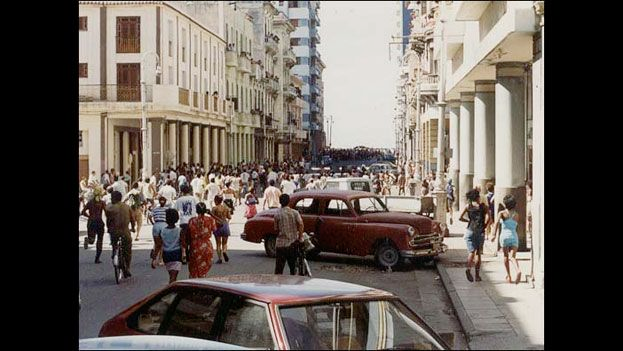
![]() 14ymedio, Generation Y, Havana, 5 August 2023 — Some were in rags, others wore masks. Some were screaming to get on a boat in Havana Bay and emigrate, others took to the streets throughout the entire island to try to change the country so as not to have to head somewhere else. In the 27 years that elapsed between the popular protest of the Maleconazo, on 5 August 1994, and the massive demonstrations of 11 July 2021 (11J), Cubans went from civic childhood to maturity. One only has to review the images of both moments to notice the tremendous change that took place in our society.
14ymedio, Generation Y, Havana, 5 August 2023 — Some were in rags, others wore masks. Some were screaming to get on a boat in Havana Bay and emigrate, others took to the streets throughout the entire island to try to change the country so as not to have to head somewhere else. In the 27 years that elapsed between the popular protest of the Maleconazo, on 5 August 1994, and the massive demonstrations of 11 July 2021 (11J), Cubans went from civic childhood to maturity. One only has to review the images of both moments to notice the tremendous change that took place in our society.
While on that morning in August the trigger was the cancellation of the trips on the Regla ferry and the impulse was given by the desire to escape the country, on 11J the cry of the streets was clearly libertarian, anti-government and socially fed up with the political and economic model imposed six decades ago. Better structured, with more consensual slogans and a democratic spirit, the protesters of two years ago were also the children and grandchildren of those who previously taken to the Malecón avenue and were beaten by the Rapid Response Brigades and by the builders of the Blas Roca contingent.
Dispersed, without leadership and overwhelmed by hunger, those who led that initial social explosion were undoubtedly more than brave. It was the first public revolt against the Cuban regime in a long time and it seemed that the indoctrination machinery and the political police had already managed to eradicate all civility from the people on this Island. It was a revolt of despair, chaotic and doomed to failure due to its lack of of organization and the mousetrap that the coastline became when the shock troops advanced on the crowd. They couldn’t do better. They didn’t know how to do better.
Despite the many differences, several common threads unite both moments. Repression was the response in both cases. While in that distant summer the oppressors disguised themselves in civilian clothes, on 11J they left modesty aside and went out to beat and arrest with all their paraphernalia of uniforms, shields and weapons. While in that cry in the middle of the Special Period it was Fidel Castro who led the crushing of citizen discontent, and only approached the Malecón when they had already managed to control the situation; In 2021, that disgraceful role fell to Miguel Díaz-Canel, who gave the “combat order” from an office and behind a desk, and unleashed the hunt for the protesters.
However, the main connection between the Maleconazo and the 11J protests is neither the behavior of the regime nor the fact that neither of the two explosions achieved democratic change on the island. Both dates are linked by something deeper and more decisive. Not only did they show Cubans’ rejection of the system, but they also evidenced the evolution of a society whose desire for freedom has not been curtailed.
________________
COLLABORATE WITH OUR WORK: The 14ymedio team is committed to practicing serious journalism that reflects Cuba’s reality in all its depth. Thank you for joining us on this long journey. We invite you to continue supporting us by becoming a member of 14ymedio now. Together we can continue transforming journalism in Cuba.
